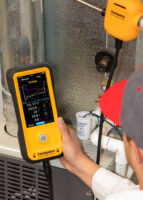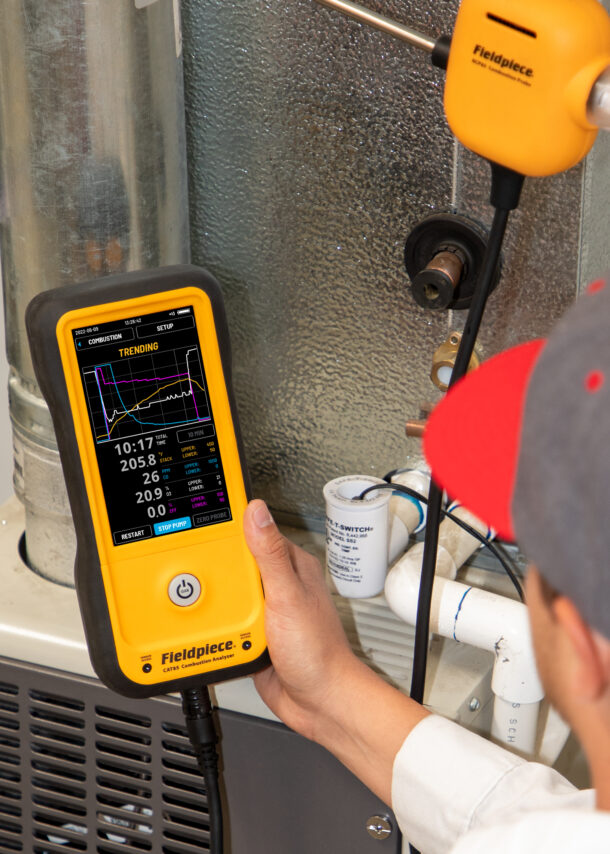Home Service businesses to benefit from focus on maintenance projects as homeowners regain financial flexibility Jobber, the leading provider of home service software, today released its latest Home Service Economic Report: 2024 Q3. The report features expert insights and proprietary data aggregated from more than 250,000 residential cleaners, landscapers, HVAC technicians, electricians, plumbers, and more, who Read more
HVAC technicians

Home Service businesses to benefit from focus on maintenance projects as homeowners regain financial flexibility
Jobber, the leading provider of home service software, today released its latest Home Service Economic Report: 2024 Q3. The report features expert insights and proprietary data aggregated from more than 250,000 residential cleaners, landscapers, HVAC technicians, electricians, plumbers, and more, who run their businesses using Jobber.
The U.S. Federal Reserve’s recent interest rate cuts are already showing early signs of impact on consumer spending, bringing cautious optimism for the home service industry. After a slower first half of 2024, Jobber’s data shows increased momentum through the end of Q3, signaling a gradual recovery fueled by improved financial flexibility for consumers. These findings are also supported by the Michigan Consumer Sentiment Index (MCSI), a monthly survey based on interviews that measure U.S. consumer attitudes towards personal finances, business conditions and economic activity.

“As we move through the second half of 2024, we’re seeing encouraging signs for the home service category—especially as financial conditions continue to improve and consumer confidence grows,” said Sam Pillar, CEO & co-founder of Jobber. “At Jobber, we’re committed to helping small home service businesses capitalize on these opportunities, and the data we’re seeing suggests a path toward sustained growth in the months and years ahead.”
Demand for Home Service Outpaces Consumer Goods
Despite fluctuations in new work volume, consumer demand for home services held steady in Q3, with spending on services outpacing consumer goods. Higher average invoice sizes helped stabilize revenue, balancing the variability in new work. As interest rate cuts improve disposable income and consumer sentiment, household spending power is expected to rise, potentially driving further growth in home service demand.
Economists anticipate that the interest rate cuts will continue into 2025, providing greater affordability in areas like mortgage rates and financing for home improvements. This environment is expected to boost activity across both the housing and home service markets as consumers look to invest in essential home maintenance and renovation projects.
The housing market remains closely tied to demand for home services, and recent data indicates a promising future for this sector. While certain indicators, such as construction spending, new permits, and housing starts, have shown temporary stagnation, the cumulative effect of rate cuts is projected to revitalize the market by mid-2025. Rising home equity and expected increases in home improvements will drive demand for both discretionary and essential projects, pushing projected annual spending to $477 billion by Q3 2025, nearing previous peak levels.
Jobber’s report includes insights on the four key segments within the home services category, revealing trends in consumer spending and business resilience:
- Green: The Green segment, which includes lawn care and landscaping, saw early growth in 2024, though activity slowed in Q3 except for July. Despite economic pressures, median revenue remained stable as homeowners prioritized smaller, recurring outdoor maintenance over large renovations.
- Cleaning: Cleaning services, including residential and commercial cleaning, have seen rising median prices but declining volumes in 2024. While new work scheduled fluctuated due to reduced consumer spending, service providers have maintained stable revenue growth by increasing prices and focusing on premium offerings.
- Contracting: The Contracting segment, covering services like electricians and HVAC, experienced a downturn in new work scheduled by late Q3. Nonetheless, median revenue stayed steady, likely due to pricing adjustments and a shift toward higher-value projects.
- Construction: Construction services, including residential and commercial projects, have seen an improvement in median revenue as consumer spending shifts toward maintenance and improvements. However, new work scheduled continued to decline in Q3, reflecting cautious spending amid the gradual economic recovery.
“The 2024 Q3 Jobber Home Service Economic Report shows a promising outlook for the home services sector as interest rate cuts start to boost consumer spending and demand,” said Abheek Dhawan, Senior VP, Strategy & Analytics at Jobber. “With rising home equity and a shift toward maintenance projects, we anticipate steady growth as financial conditions improve. The sector is well-positioned to benefit from an aging housing stock and increased focus on essential updates, setting the stage for sustained demand and expansion through 2025 and beyond.”
To download the Jobber Home Service Economic Report: 2024 Q3, visit: https://getjobber.com/home-service-reports/nov-2024/

New integration marks CallRail’s commitment to expanding investment across the home services category CallRail, the AI-powered lead intelligence platform, today announced an integration with Jobber, the leading provider of operations management software for home service businesses. With this integration, mutual customers—such as landscapers, plumbers, HVAC technicians, and painters—will get a better understanding of the performance of Read more
New integration marks CallRail’s commitment to expanding investment across the home services category
CallRail, the AI-powered lead intelligence platform, today announced an integration with Jobber, the leading provider of operations management software for home service businesses. With this integration, mutual customers—such as landscapers, plumbers, HVAC technicians, and painters—will get a better understanding of the performance of their acquisition channels and gain deeper insights into those leads to win more business without having to leave the Jobber platform.

By connecting to the CallRail app in the Jobber app marketplace, service pros will be able to see how potential leads discovered their business, the connection between the marketing sources and keywords that led to booked jobs, and view the communications history each lead had with their business.
“Teaming up with Jobber continues our longstanding commitment to supporting home service professionals as the only lead intelligence software directly integrated into technology that services pros are already using everyday,” Marc Ginsberg, CallRail CEO, said. “Our technology automatically surfaces actionable insights from calls and highlights the marketing activities that are bringing those leads. Now, these insights are available within the Jobber platform and connected with job-specific data to help service pros know what’s bringing their most profitable jobs.”
While the home service category continues to see a steady demand for services, advertising costs have increased significantly, causing many businesses to rely on lower cost lead generation services. The partnership will specifically enable mutual customers to easily access unprecedented details about customer journey, from lead to job, as well as unparalleled access to customer conversation data through CallRail’s Conversation Intelligence® platform. This will be especially important in 2024 as service pros will need to consider alternative ways to grow revenue and save on costs according to the latest Jobber Home Service Economic Report.
“Spending money on marketing can be intimidating for home service businesses, which often operate on tight budgets where every dollar counts,” said Sam Pillar, CEO and co-founder of Jobber. “These entrepreneurs want assurance that their hard-earned dollars are being invested efficiently. At Jobber, we want to take the guesswork out of running a successful home service business and provide the right tools for service pros to win work faster. This integration with CallRail is a great example of how we are doing that.”
“Marketing is critical to the success of our home services business, but wasting money on ads that don’t bring in leads can be detrimental,” said Branden Sewell, Owner of Seal Pro Painting. “Knowing where leads are coming from helps me know which marketing strategies are working effectively, and which ones need to be adjusted or scrapped. It saves time, money, and allows our business to focus on what matters most: booking jobs and getting paid.”
To learn more about how home service pros can make the most of this partnership, visit: https://callrail.com/blog/jobber-integration-easier-lead-management

The purpose of combustion analysis is to help HVAC technicians ensure fuel-fired heating appliances are running safely and efficiently. Long gone are the days of checking efficiency by the color and shape of the flame. Combustion analyzers measure and calculate a range of variables such as flue temperature, draft pressure, and the byproducts of combustion Read more
The purpose of combustion analysis is to help HVAC technicians ensure fuel-fired heating appliances are running safely and efficiently. Long gone are the days of checking efficiency by the color and shape of the flame. Combustion analyzers measure and calculate a range of variables such as flue temperature, draft pressure, and the byproducts of combustion like oxygen (O2), carbon dioxide (CO2) and carbon monoxide (CO). To tap into the full power of your combustion analyzer, here are a few tips and best practices to keep in mind this heating season.

Location, Location, Location
Combustion analysis is all about location. Key measurements are taken in the flue gas after the heat exchanger and prior to any dilution air entering the flue. Typically, the ideal location to measure combustion byproducts, such as CO, is about a foot above the furnace box and at least a foot away from any elbow. Using an existing combustion test access fitting is preferred over drilling into the flue. If an access location must be drilled, reseal the hole following testing with a silicone plug for example, to ensure exhaust gases are not vented into the surrounding space. Silicone is resistant to heat and moisture in the flue, providing a sure seal. When you insert the probe, use a cone lock to hold the sampling tip in the center of flue, at the hottest point.
Warm-up
The best practice is to warm up and insert the combustion analyzer probe prior to firing up the furnace. All measurements should be monitored at start-up, after a system has stabilized and after light out (unit turned off). The analyzer should be turned on and allowed to warm up in fresh air, in order to zero the ambient CO sensor. Avoid starting the analyzer near the exhaust pipe of a service van, or in the furnace room. After the start-up tests, it’s also important to let the furnace run for a few minutes to stabilize before measuring combustion performance.
Monitoring Carbon Monoxide (CO)
During the installation or service of a heating appliance, the fuel and airflow are adjusted to maximize combustion efficiency and safety. If the adjustments allow too much fuel or too much oxygen into the reaction, the imbalance will lead to incomplete combustion. When this happens, it can create a dangerous amount of CO. While you should always defer to the furnace manufacturer’s recommendations and local regulations, what follows are a few key tips when monitoring CO levels.
After the burners light, the CO should rise and fall and the O2 should slowly fall, and both should stabilize within a few minutes. If the CO or O2 levels spike suddenly after the blower starts on a warm air furnace, it is a sign the heat exchanger is compromised in some way. If the CO sensor oversaturates, immediately bring the probe into fresh air, and let the analyzer pump run until the CO displayed level is at or near zero.
Combustion Analyzer Maintenance
To keep your combustion analyzer ready for every heating season job, there are a few recommended maintenance tips. Always drain the analyzer water trap (if applicable) and check the dust filter regularly. When testing is complete, run the pump until CO, O2 and temperature readings return to ambient, removing any residuals from the sensors and analyzer. Also, when you’re powering the combustion analyzer down, ensure the probe has cooled to ambient temperature before inserting it into the carrying case. And finally, it is recommended that sensors be calibrated annually or as required by local regulations.
Let Your Combustion Analyzer Do the Work
A combustion analyzer is a powerful tool to help you keep fuel-fired heating appliances running efficiently and safely. Therefore, the biggest tip is that combustion analysis should be the first and last thing completed during any heating appliance repair. The outlined tips not only help ensure peak performance, but they help you prioritize safety and the use of best practices in your analysis procedures.
 Tony Gonzalez is the Technical Training Manager for Fieldpiece Instruments.
Tony Gonzalez is the Technical Training Manager for Fieldpiece Instruments.
